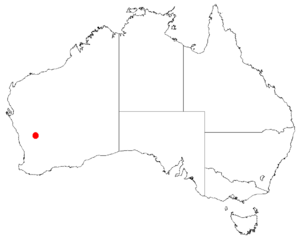Acacia unguicula facts for kids
Quick facts for kids Acacia unguicula |
|
|---|---|
| Conservation status | |
| Scientific classification | |
| Genus: |
Acacia
|
| Species: |
unguicula
|
 |
|
| Occurrence data from AVH | |
Acacia unguicula is a type of shrub that belongs to the Acacia plant family. It is found only in a small area in the Mid West region of Western Australia.
Contents
What is Acacia unguicula like?
This shrub usually grows upright and can be between 0.75 to 2 meters (about 2.5 to 6.5 feet) tall. Some can even reach 3 meters (about 10 feet) high. It has smooth, grey bark.
Its leaves, called phyllodes, are stiff and point upwards. They are olive green and grow in bunches near the ends of the branches. These phyllodes are narrow and have a strong smell. They can be up to 40 millimeters (about 1.5 inches) long and 4 millimeters (about 0.15 inches) wide. Each phyllode has 14 to 16 clear veins.
The plant blooms from August to September, showing off bright yellow flowers. These flowers grow in round clusters, about 5 to 6 millimeters (0.2 inches) wide. Each cluster has 24 to 34 flowers on stalks that are 7 to 11 millimeters (0.3 to 0.4 inches) long. After flowering, reddish-brown seed pods form. These pods are long and thin, often coiling up. They are usually about 60 millimeters (2.3 inches) long and 2 millimeters (0.08 inches) wide.
Where does Acacia unguicula live?
Acacia unguicula is only found in three groups of plants. These groups are located on a large farm area called a pastoral lease at Mount Singleton. This spot is about 280 kilometers (174 miles) south-east of Geraldton in Western Australia, close to Yalgoo.
You can find this plant growing on the higher parts and top of Mount Singleton. It lives among open scrubland, which is a type of bushland. The plant grows in rocky clay, brown sandy clay, or brown loamy soils. These soils often contain a type of rock called dolerite.
How was Acacia unguicula discovered?
Two botanists, Richard Sumner Cowan and Bruce Maslin, first officially described this plant in 1990. They wrote about it in a scientific paper called Acacia Miscellany 3. This paper was published in a journal named Nuytsia.
Over time, this plant has also been known by other names. These include Acacia unguiculata, Racosperma unguiculatum, and Racosperma unguiculum.
Why is Acacia unguicula in danger?
This plant is in serious trouble. In 2006, it was listed as a critically endangered species. This means it faces a very high risk of disappearing from the wild.
The area where Acacia unguicula grows is very small, less than 1 square kilometer (about 0.4 square miles). There are only about 43 adult plants left in total. One of the main reasons for its small population is animals eating the plants. Goats, in particular, graze on them a lot, which makes it hard for the plants to survive and grow.


